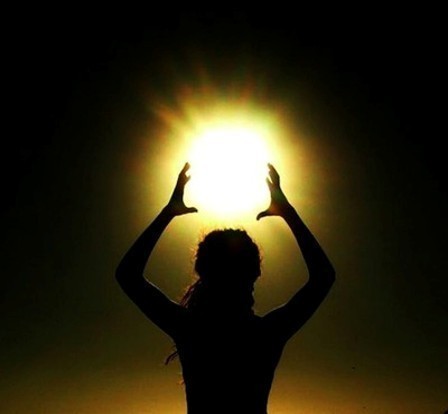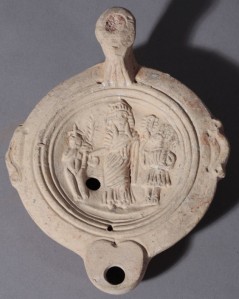The return of the light, here and now—in mid-winter—is always a hopeful time. And I do feel hopeful; more now than in the past year. When more light fills our eyes, breath comes a bit easier and hope may come to our hearts.
Isis is like that: a deep, hopeful, uplifting breath. It is one reason that She is, among so many other things, a Lady of Light. She is found in the light of the sun, the moon, and the stars. She is found in light itself.
In ancient Egypt, they held Festivals of Lights in which the entire town or city would light oil lamps that would burn throughout the night—entirely equivalent to our own stringing of lights at Halloween, Yule, or the Winter Festival of Lights that my own city of Portland puts on every February. In Egyptian homes, it was in the space before the main gate of the house that a lot of a family’s festival activity—from lamp lighting to barbecuing and feasting, would take place. I assume this enabled everyone to celebrate together and to see each other do so. In my imagination, I envision Egyptian neighbors vying with each other over elaborate displays of oil lamps.
The historian Herodotus (5th century BCE) writes about an ancient Festival of Lights at Sais, the city of Neith. He says:
“At the times when they gather together at the city of Sais for their sacrifices, on a certain night they all kindle lamps many in number in the open air round about the houses; now the lamps are saucers full of salt and oil mixed, and the wick floats by itself on the surface, and this burns during the whole night; and to the festival is given the name Lychnocaia (“Lamp Lighting”). Moreover those of the Egyptians who have not come to this solemn assembly observe the night of the festival and themselves also light lamps all of them, and thus not in Sais alone are they lighted, but over all Egypt: and as to the reason why light and honour are allotted to this night, about this there is a sacred story told.”
—Herodotus, Histories, Book II, Chapter 62
Sais was one of the sacred cities in which Isis was said to have buried a piece of Osiris’ body. There, possibly at a sacred lake at Neith’s temple, an Osirian passion play was enacted at the same time as one of these festivals of illumination. (Just to be clear, this Egyptian festival was in summer, not at mid-winter…but was a festival of light nonetheless.) And, you may know, that at Sais, Isis and Neith were assimilated, so having Osirian festivals at Neith’s temple would not have been a stretch for the ancients.
I’ve read in a couple places that the “sacred story” attached to the Sais festival to which Herodotus refers was that the lights were to assist Isis in Her search for the body of Osiris. Unfortunately, nobody has footnoted this reference, so I’m not sure if it’s something ancient or simply a modern scholar’s best guess. I love the idea of the whole town assisting Isis in Her search with light…and it makes sense given the passion play and grave of the God at Sais. What’s more, the Egyptians usually did have a mythic model for ritual activity, but I still haven’t found out who originated that explanation. I’ll let you know if I do.
We also know of ancient Egyptian festivals of light at the New Year and on the five epagomenal days that led up to it. On these days, the birthdays of Osiris, Horus, Set, Isis, and Nephthys were celebrated and lights were placed in tombs for the dead. A temple calendar from Edfu tells us of a summertime procession for Isis the Brilliant. That festival is celebrated by modern Kemetics as the Aset Luminous Festival. And so there are more lights for the the Lady of Light.
Now let’s leap forward in time some hundreds of years and move from Egypt to Rome.
The 4th-century-CE Calendar of Philocalus lists a festival called the Lychnapsia on August 12th. It was, of course, a lamp-lighting festival. The scholars who have studied it seem reasonably certain that it was an Isis festival because a.) the August 12th date of this lamp festival is at roughly the same time as the great Egyptian Festival of Lights at the epagomenal birthdays of the Deities and b.) Isis was so extremely popular in Rome that anything Egyptian would have also been considered Isiac.
Furthermore, the theory is that the August 12th date (due to some calendrical calculations with which I will not bore you) corresponded to the 4th epagomenal day—and the 4th epagomenal day is the birthday of Isis. So, in 354 CE, Isiacs could celebrate the birthday of Isis by the lighting of lamps in Her honor.
But we need not wait for the summer birthday of the Goddess or the procession of Isis the Brilliant to honor the Lady of Lights with light. After all, the Egyptians celebrated illumination festivals at a number of different times during the year.
And so I have a modest proposal: a Festival of Lights for Isis as the light-bringing Lady of the Deep Breath. In this mid-winter time, as Her solar light begins its return and Her warming breath infuses our bodies and stirs our souls, as the Green Goddess’ green shoots struggle to be born even while covered with a silver layer of snow, so let us breathe Her in and celebrate, yet another, new beginning.
Such interpretations and updating of our traditions is precisely what we human beings have always done. It enables us to connect with the richness of the past and also to have traditions that continue to make spiritual and emotional sense to us. No doubt, the festivals for Isis changed over time. No matter how conservative the ancient Egyptians were, still, things change. They changed over time within the borders of Egypt, and then when the worship of Isis came into the wider Mediterranean area, things changed even more. People who came to love Isis celebrated Her in ways rooted in tradition, but which made spiritual sense to them in their day, too.
I therefore invite you to join me in a small, new, mid-winter festival for Isis, Lady of the Dawning Light, Mother of the Deep Breath, Queen of Hope. Light a candle, a torch, a tea light. Watch the flame. Feel the light. And breathe Her breath with me.







